Cationic Polymers
Poly(ethylene imine) was analyzed using OHpak SB-804 HQ and SB-803 HQ (columns for aqueous SEC (GFC)).
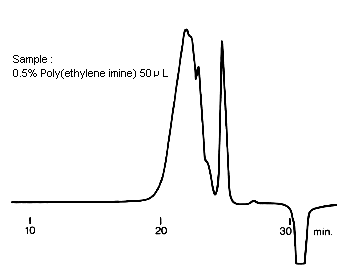
Sample : Poly(ethylene imine)
Columns : Shodex OHpak SB-G (6.0mmID*50mm) + SB-804 HQ + SB-803 HQ (8.0mmID*300mm each) Eluent : 0.5M Acetic acid + 0.5M Sodium acetate aq. Flow rate : 1.0mL/min Detector : Shodex RI Column temp. : Room temp.
Poly(allylamine) is one of the cationic polymer. In SEC analysis of cationic polymer, the selection of eluent which prevents ionic interaction and hydrophobic interaction between a sample and gel makes measurement successful. In order to control the ionic interaction between a sample and gel, salt should beadded to the eluent. But if the salt containing multivalent anion such as phosphate or sulfate is used, a sample may not dissolve or a sample may precipitate after the dissolution. On the other hand, if the salt containing one valent anion such as nitrate and chloride is used, precipitation of a sample will not take place. Here, the influence to the chromatogram of the salt concentration in the eluent was investigated under the various concentration of sodium nitrate in the eluent. In order to reduce hydrophobic interaction between a sample and gel, 0.5M acetic acid was added to the eluent. Comparison of chromatograms of poly(allylamine) measured under the various concentration of sodium nitrate in the eluent is shown in Fig.1. In the case of 0.02M sodium nitrate in the eluent, the constituent of high molecular weight of poly(allylamine) is adsorbed to the gel material and is not eluted from a column. When the salt concentration of sodium nitrate is more than 0.1M, the adsorption of a sample is suppressed and a right chromatogram is obtained. The relation between the molecular weight of poly(allylamine) and elution volume with SEC/MALS is shown in Fig.2. Under the 0.1M – 0.2M of sodium nitrate in the eluent, poly(allylamine) is eluted in the molecular weight order. The relation between the RMS radius (size of the molecule in the solution) of poly(allylamine) and elution volume with SEC/MALS is shown in Fig.3. When the concentration of sodium nitrate is low, molecule of the polymer spreads out and RMS radius becomes large, as the result, poly(allylamine) is eluted early. When the salt concentration is 0.1-0.2M, we can see the influence of the diffusion of molecule is decreasing according to the salt concentration, and separation is performed in the molecular size order. From the above result, in the measurement of poly(allylamine) with SB-806M HQ, the eluent of 0.5M acetic acid + 0.1M – 0.2M sodium nitrate is sutable for this analysis.
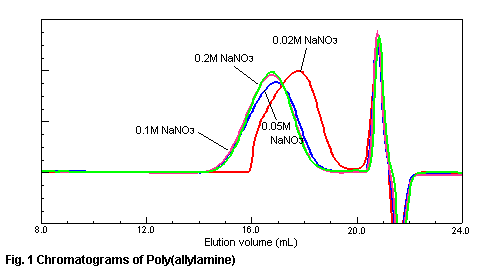
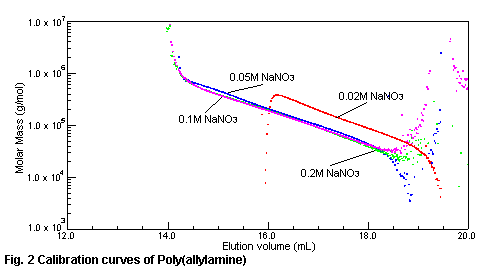
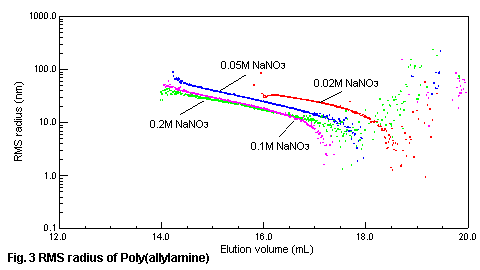
Sample : 0.2% Poly(allylamine), 100micro-L
Columns : Shodex OHpak SB-806M HQ (8.0mmID*300mm) x 2 Eluent : 0.5M CH3COOH + nM NaNO3 aq. Flow rate : 1.0mL/min Detector : Shodex RI, MALS(Multi-Angle Laser Light Scattering Detector) Column temp. : 40deg-C
Comparison of chromatograms of poly(ethylene imine) depending on the concentration of sodium nitrate in the eluent is shown in Fig.1. In the case of 0.02M – 0.05M sodium nitrate in the eluent, the constituent of high molecular weight of poly(ethylene imine) is adsorbed to the gel material and is not eluted from a column. When the salt concentration of sodium nitrate is more than 0.1M, the adsorption of a sample is suppressed and a right chromatogram is obtained. The relation between the molecular weight of poly(ethylene imine) and elution volume with SEC/MALS is shown in Fig.2. In the case of 0.1M – 0.2M sodium nitrate in eluent, poly(ethylene imine) is separated in the molecular weight order. The relation between the RMS radius (size of the molecule in the solution) of poly(ethylene imine) and elution volume with SEC/MALS is shown in Fig.3. When the concentration of sodium nitrate is lower than 0.05M, the constituent of high molecular weight of poly(ethylene imine) is adsorbed to the gel material and is not eluted, and the RMS radius of eluted polymer becomes large. When the salt concentration is 0.1M – 0.2M, the influence of the diffusion of molecule is decreasing according to the salt concentration and separation is performed in the molecule size order. From the above result. For the measurement conditions of poly(ethylene imine) with OHpak SB-806M HQ, the eluent of 0.5M acetic acid + 0.1M – 0.2M sodium nitrate is sutable for this analysis.
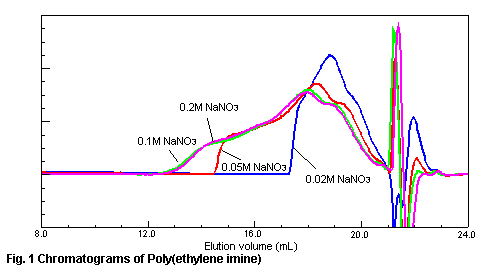
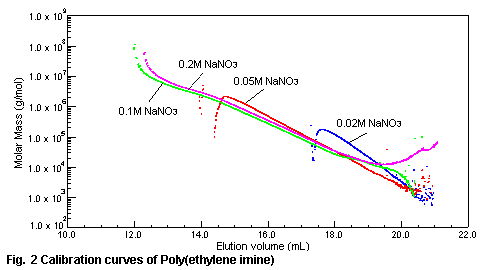

Sample: 0.2% Poly(ethylene imine), 100micro-L
Columns : Shodex OHpak SB-806M HQ (8.0mmID*300mm) x 2 Eluent : 0.5M CH3COOH + nM NaNO3 aq. Flow rate : 1.0mL/min Detector : Shodex RI, MALS(Multi-Angle Laser Light Scattering Detector) Column temp. : 40deg-C
Chromatogram of poly(diallyl dimethyl ammonium chloride) analyzed with SEC/MALS is shown. The relation between a molecular weight and elution volume shows separating in the molecular weight order.
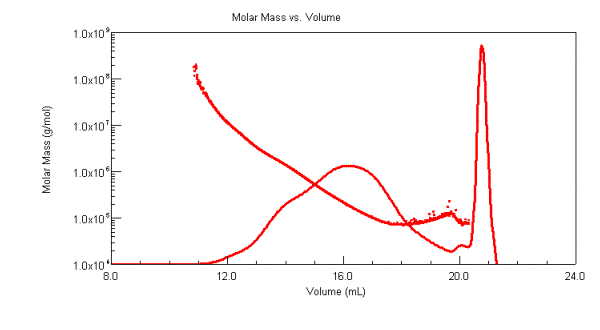
Sample : 0.2% Poly(diallyl dimethyl ammonium chloride), 100micro-L
Columns : Shodex OHpak SB-806M HQ (8.0mmID*300mm) x 2 Eluent : 0.5M CH3COOH + 0.1M NaNO3 aq. Flow rate : 1.0mL/min Detector : Shodex RI, MALS(Multi-Angle Laser Light Scattering Detector) Column temp. : 40deg-C
